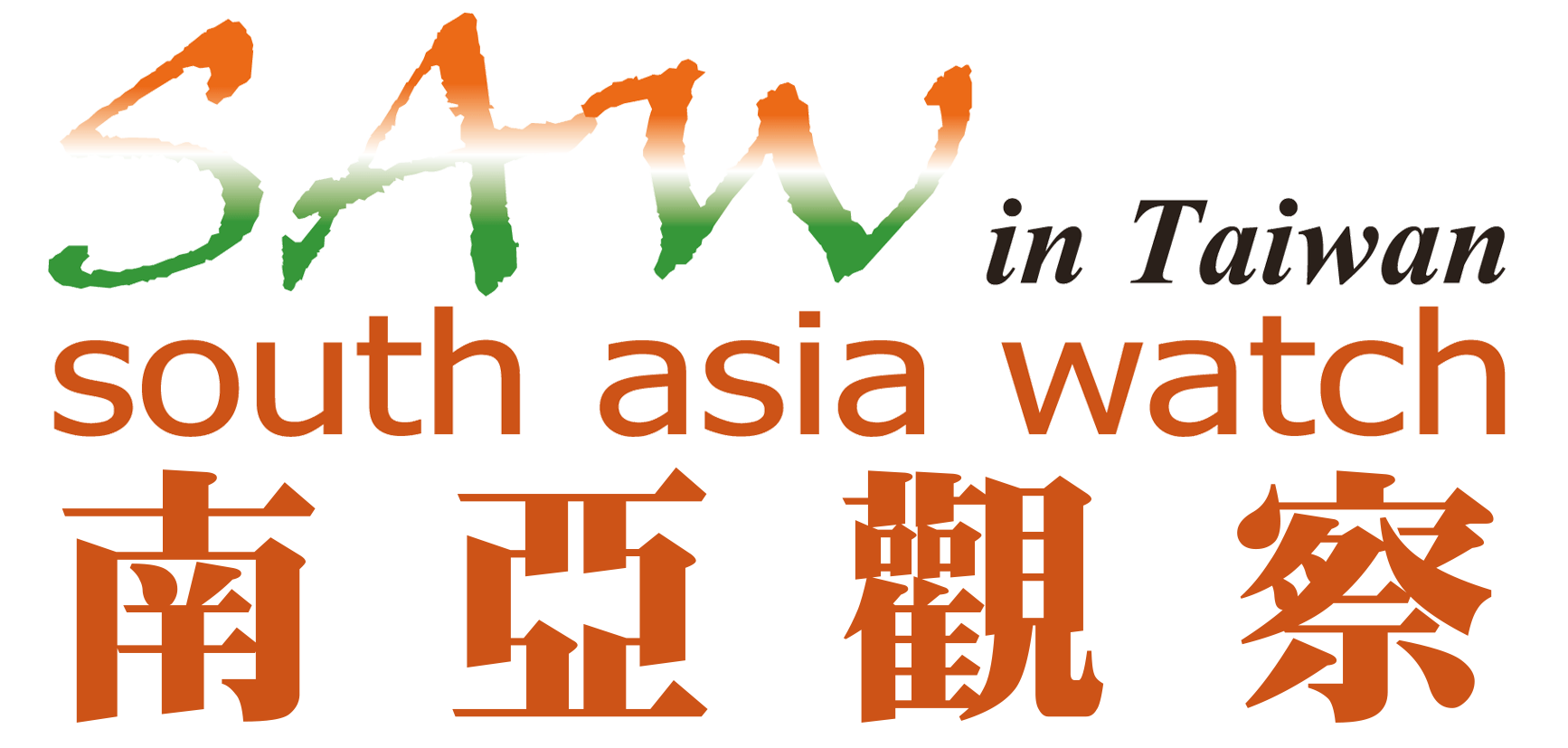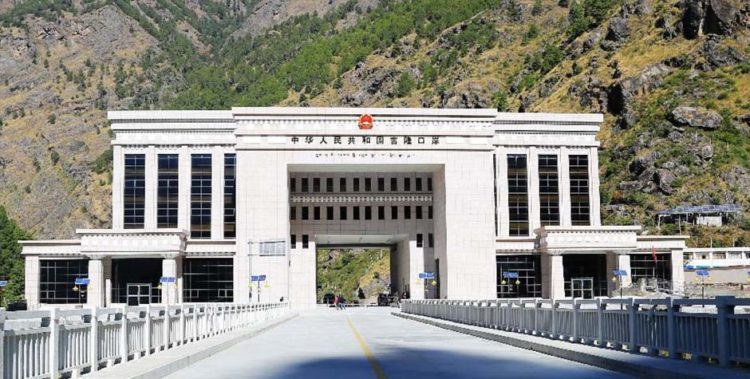
(source)
Uddhab P. Pyakurel
Assistant Professor in School of Arts, Kathmandu University, Nepal/ Academic Advisory Committee of CSSAME
The issue of Nepal-China border management has been in forefront once again along with the blockade experienced by Nepalis in Nepal-India border in 2015 just after Nepal promulgated its new constitution. In fact, the Indian blockade further proved that Nepal is not only a landlocked but also practically an India locked country. It was partly because the role performed by Nepal’s northern border-Tibetan Autonomous Region of China. If one could see Chinese role to help Nepal to overcome crisis, it could do almost insignificant help to Nepal. And it was not that China was unable to assist Nepalis but it did not do much.
本文將敘述在中國介入之前,尼泊爾和西藏之間的歷史和近鄰關係,並分析彼此的關係是如何變成現今只流於形式及辭令的情況。
The major reason behind the insufficient support was a long-practiced Chinese interest that is not to invite further complication by opening the Tibetan border. In an Interview[1], the author argued that Nepal-China relations started facing a crisis since 1792, and it was weakened further after China invaded Tibet in early 1950s. I further argued saying that Nepalis sometime blame our own government and leaders for its unpreparedness or unwillingness to resume people to people relations of Nepal-Tibet border, which is unfair because the responsibility goes to China and its security concerns in Tibet. For me, both the Chinese attempts i.e. decision to close Khasa border citing damage by last year earthquake, and proposal to open Rasuwagadi border are not real but tactical. However, a significant number of Nepalis still believe that China may be seen as an option to alter and diversify its economic dependence on India.
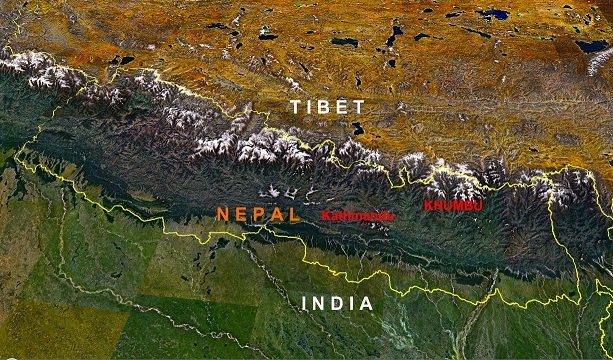
(source)
This paper narrates the historical and proximate relationship between Nepali and Tibet before China came to picture, and analyzes how this relationship has come to the existing stage that is only formal and rhetoric one.
- Historical border relations between Nepal-Tibet
Nepal shares 1,415 kilometers border with Tibetan region of China. Since the borderlands are mainly of Himalayan range, more than 90 percent of Nepal’s frontiers with Tibet run through almost uninhabited altitudes with some pasturage areas, rocks, and snow; glaciers and ice fields. The majority Nepalis of the border is of Mongol origin and they have Tibetan affinities. That is why they were called Bhotiya, meaning people from or similar to Bhot (Tibet). Traditionally, the people from bordering areas of both Tibet and Nepal were to raise yaks and produce crops i.e. potatoes, barley, buckwheat, millet, etc. However, once Kathmandu turned into a prime center of trans-Himalayan communications and a meeting ground of traders of Nepal, British-India and Tibet, people from major bordering points i.e. Kerung, Kuti started being active in trade, tourism and trekking related businesses.
Till recently, the overland trade between Nepal and Tibet (China) was conducted through six border points —- Kodari / Nyalam, Rasuwa / Kerung,Yari (Humla) / Purang, Tinker / Purang, Olang-Chungola / Rui and Kimathanka / Rui with Tatopani customs as the largest checkpoint.
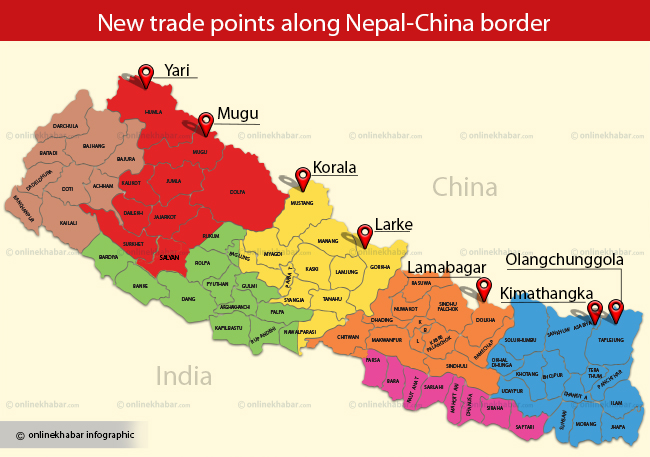
(source)
Here is a brief introduction of existing border passes which had a possibility to developing as trade and transit routes between Nepal and Tibet:
- Olangchungola (Tiptala Pass): It is the border point with the nearest Chinese market of Riwa Bazaar which is some 360 kilometer away from Indian market Panitanki/Galgalia.
- Kimathanka (Lengdup): It is the border point with the nearest Chinese market of Riwa Bazaar which is some 40 kilometers away from Nepal-India border market of Jogbani.
- Lamabagar (Lapchi): It is the border point with the nearest Chinese market of Phalek that is some 240 kilometer away from Bhittamode of India.
- Gorkha Larke (Lajyang Pass): It is the border point with the nearest Chinese market of Kungtang which is some 420 kilometer away from Nepal-India border point-Thori.
- Mustang (Korala): It is the border point with the nearest Chinese market of Zhongba which is some 448 kilometer away from Sunauli bazaar of Nepal-India border.
- Mugu (Nagcha): It is the border point with the nearest Chinese market of Hyazimang which is some 374 kilometers away from Rupaidiya of India.
- Humla (Hilsa): It is the border point with the nearest Chinese market of Sera which is some 473 kilometers away from Nepal-India border market of Gaurifanta.
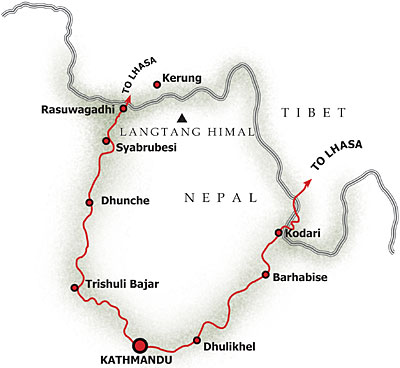
(source)
It is said that the 7th century political instability in Tibet helped facilitate Nepal to monopolize Tibetan trade, which was further expanded during medieval period regulating trade traffic between India and Nepal. And, opening of the Kerung route in 17th century was instrumental in developing closer interaction among China, Tibet, India and Nepal. Though Kerung is an ancient trade route where Nepali and Tibetan armies fought war several times until the last treaty of Thapathali was signed between Prime Minister Janga Bahadur Rana and Kolan Shatra from Tibet side in 1856, it was under the shadow until the opening and operationalization of the Kodari-Khasa border point. The Kodari-Khasa border point which was the only border point in operation till recently is also closed last year (by April 2015) by China citing safety reasons. Though China cited April 2015 earthquake and its impact on the borders areas as major causes of the shutdown of the Kodari-Khasa border, it was primarily due to China’s security concerns.
Then, China talked about opening Rasuwagadi (Kerung) border that has been welcomed by Kathmandu as if China has shown a great sympathy for Nepalis. But evidences show that Chinese proposal to strengthen activities through Kerung border was just to avoid negative impressions about China in Nepal along with the closer of Khasa border while Nepalese were facing blockade from their southern neighbor. There have been a couple of bilateral meetings of Nepal-China-Tibet Trade Facilitation Committees to discuss the issue of the closer of the border but it is reported that the Chinese officials keep promising to open it but do not confirm when they would open the customs points.
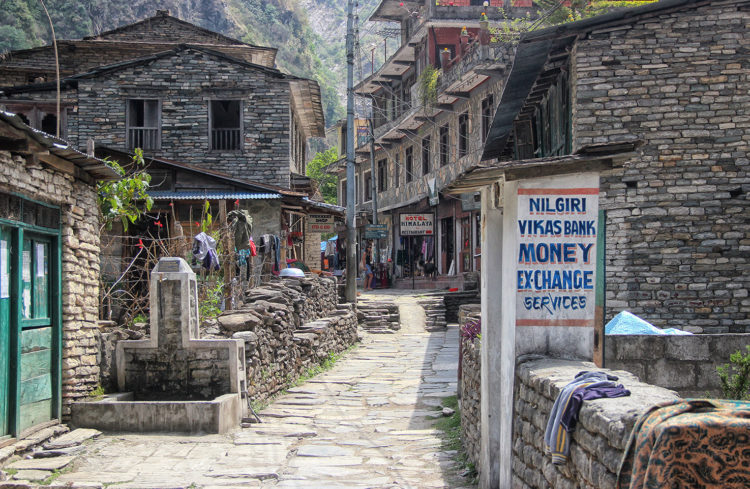
( Tatopani ,source)
Nepali officials share that, “we have been told that roads on the Chinese side have also been affected due to the earthquake and there might also be other reasons of safety and security. We had requested the Nepali Consul General Office in Lhasa through the Ministry of Commerce and Supplies and Ministry of Foreign Affairs to help open the border points. However, there has been no indication when the Tatopani and Rasuwagadhi border points would be opened for trade”.[2] The senior bureaucrats of Nepal who are quite hesitant to disclose openly about Chinese interest to linger the issue of opening the recently closed Khasa border, seem to have lost their hope to reopen the Kodari-Khasa. Since China’s concern to close the only working border-Tatopani is now in surface, the bureaucrats started doubting about the opening of Keyrung border questioning ‘how China feels secured enough to open up another border point Rasuwagadi if it has closed Khasa border to control human interactions. As everyone knows that the Tatopani border-the only operating border between Nepal and Tibet, was also closed by China at the time when Nepal was facing blockade in Nepal-India border. Other experiences, i.e. the Korala border[3] point also helped Nepali authorities to conclude that China is not ready to allow Nepal to continue interacting with bordering people of the Tibetan areas.
- Chinese attempts to tighten Nepali-Tibetan interaction
The often shift in the treaty/agreement provisions presented below seems to be helpful to understand how slowly and deliberately the restriction on the people’s movement was imposed in the Nepal-Tibet border by China.
- Nepal-China Treaty, September 20, 1956:
Article 8: The Nepalese Primary schools in Lhasa of the Tibet region of China shall be changed into a primary school for children of Nepalese nationals and shall complete registration procedures in accordance with the relevant regulations of Chinese government.
Paragraph 5(2): traders of the two countries known to be customary and specifically engaged in trade between the Tibet Region of China and Nepal, their wives and children dependent on them for livelihood and their attendants shall hold passports issued by their respective countries and visaed by other party or certificates issued by their respective governments or by organs authorized by their respective governments.Para 5 (3): Inhabitants of the border districts of the two countries who cross the border to carry on petty trade, to visit friends or relatives, or for seasonal changes of residence, may do so as they have customarily done herefore and need not hold passports, visas or other documents of certifications. Similar facility was offered to pilgrimages of either party who travel across the border for the pilgrimage purpose, except to register at the border checkpoints, and take permit from the first encountered authorized government office of the party.
- The trade agreement signed on the May 19, 1964:
Article (VII) “border inhabitants of the two countries may, within an area of 30 Kilometers from the border, carry on the petty traditional trade on barter basis, which shall not be subjected to the limitations of the above mentioned provisions”.
- The Agreement on Trade, Intercourse and Related Questions between TibetAutonomous Region of China and Nepal (Peking May 2, 1966):Inhabitants of the border districts of the two countries who cross the border to carry on petty trade, to visit friends or relatives, or for seasonal changes of residence, may do so as they have customarily done herefore and need to register at the border checkpoints, and take permit from the first encountered authorized government office of the party.Also, article 1 (6) suggested border habitants both countries to use the customary routes while travelling across the border.
- Agreement on Trade Intercourse and Related Questions between Tibet Autonomous Region of China and Nepal signed in Beijing on the August 1, 1986:Article 3 for the border habitants and stated: “Inhabitants of the border districts of the two countries who cross the border to carry on petty trade, to visit friends or relatives, or for seasonal changes of residence shall hold border inhabitant certificates issued by concerned authority”… and need to register at the border checkpoints, and take permit from the first encountered authorized government office of the party.Article 7: “provided that existing practices may continue until such specifications. However, they shall not be allowed to proceed to the interior of the other country”.
- Agreement on Trade and other related matters signed in Beijing on July 10, 2002:Article 2: “traders may be given visas for single, double or multiple entry valid for one year depending of the situation and their needs”Inhabitants of the border districts of the two countries who cross the border to carry on petty trade, to visit friends or relatives, or for seasonal changes of residence shall hold exit-entry passes of the border districts.”
Going through the above-presented data, one could say that the whole episode was done with China’s interest, and the Chinese moved to eliminate both the local trade carried on by the inhabitants of the Nepal-Tibet border and the traditional transportation trans-border pasturage-usage system under which pasture on both sides of the boundary were used at different times of the year by Nepali and Tibetan herdsmen. The 1956 China-Nepal trade treaty which allowed the continuation of these customary practices, was abrogated by 1962 as Chinese were “unwilling to agree to a further extension”. As a result, the economy of the border area in which these traditional privileges had long played an important role was adversely affected along with the agreement. It is said that the Nepali side had raised the question in the 1968 trade talks in Peking but the Chinese were unwilling to agree.
Here, one can easily conclude that there is no ray of hope for having a positive perception towards China as far as human mobility in the Nepal-Tibet border is concerned. Those who still see China as an alternative or better one than India to help Nepal have either ignored the recent attempts of China to tighten Nepal-Tibet border or are unknown about the warm and proximate Nepal-Tibet relations before China came to the picture. In fact, many Nepalis have no knowledge about Nepal’s relation with Tibet which was very proximate than with India today. It was due to the fact that travel and interaction with the North was easier and safe compared to travel towards South at least until the 19th century. As a Sociologist Dor Bahadur Bista[4] mentions, until the beginning the 19th century, Nepal shared greater cultural affinity with, and had greater economic interest in, Tibet than India. Also, there were more Nepalis in Tibet than anywhere else in South Asia. The dense sub-tropical forest to the south, with its diseases, wild animals, and all kinds of evil sprits, demos, monsters, dacoits and robbers were the major cited causes to consider the Southern border unsafe and insure.
Also, Nepalis were the one who were there in Tibet with a couple of privileges. For example, Nepalis businessmen were allowed to marry Tibetan women and male offspring of such marriage were regarded as Nepali subjects (popularly known as Khachara) whereas female child from such a marriage (Nepali father and Tibetan Mother) was acknowledged as a Tibetan citizen. The then Tibetan government had agreed to accept the arrangement and granted the Khacharas[5] the privileges and facilities accorded to Nepali traders in Tibet.
According to an account by a British diplomat Charles Bell who was in Tibet during the 1920s, there were around 600/700 Nepali traders and approximately 1000 alone in Lhasa. The Kerung route was opened in the 17th century which provided the ground to develop a closer interaction among China, Tibet, India and Nepal. It was Tibet, which was paying annual tribute of Rs. 10000.00 to Nepal until 1953; the provision was nullified it as per the Communist China’s request to contemplating closer diplomatic relations with China. The Thapathali Treaty signed in 1956 by Tibet and Nepal had allowed all Nepalese to do business in Tibet without any hindrance. With an exception of armed soldiers, the treaty had also allowed all Nepalis to travel freely in Tibet.
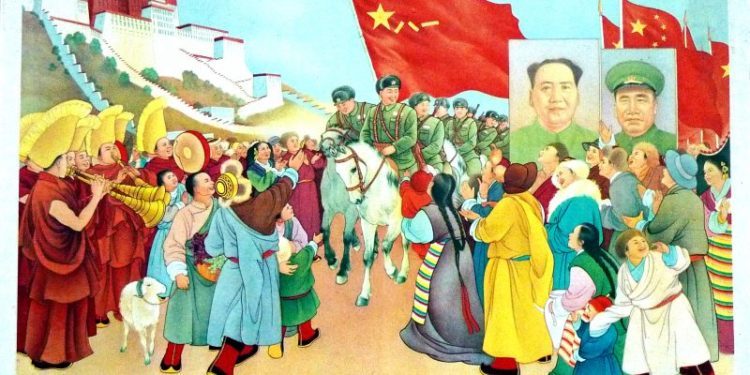
(source)
However, one sees a drastic paradigm shift not only on the trade but also on aspects of human mobility and other cultural relationship between two bordering neighbors along with Chinese expedition to Tibet in 1949. Though Nepal continued its interactions with Tibet for a couple of years even after Tibet was invaded by China, the situation was changed once China formally established diplomatic relationship with Nepal in 1955. It was the agreement China signed with Nepal on the 20thSeptember 1956 which started controlling the movement of people from one country to another by abrogating all the treaties and documents which existed in the past between Nepal and Tibet and also Nepal and China. People to people relations between two sides of the border were weakening further once Nepal and China exchanged their residential ambassadors in July 1960. Issues i.e. territorial disputes[6] put both the customary trade links and trade routes under shadow.
To conclude, China’s decision to close Khasa border, attempt to open Kerong border, and promises to facilitate trade from other possible border points do not seem to be new. It is only the repetition of its old approach. It was China which opened Khasa point and helped construct Kodari highway as per its’ interest to eliminate the role of the private Nepali trader in Tibet with direct State to State trading[7]. It has no interest of letting people of bordering areas to interact with each other. If China is against such interactions, neither China-Nepal trade grows faster nor does transit facility which is assured by China in its recent agreement with Nepal last year will be smooth. Here, Nepal needs to recall BP Koirala’s hints that he dropped in 1960 before construction of Kodari highway: “we do not build roads (railways) for strategic reasons” if such an infrastructures had no economic justification.
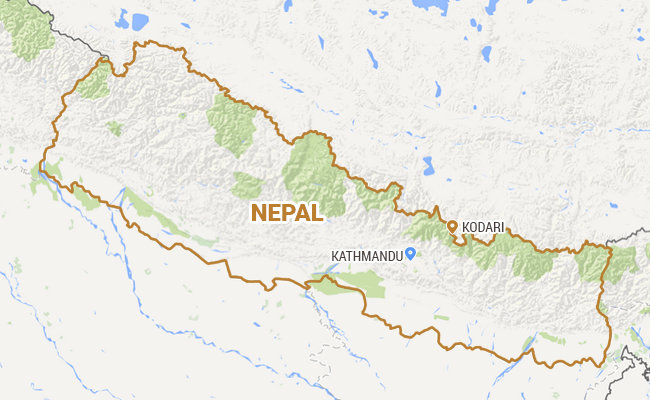
(source)
[1] For details, see “Neither Prachanda would be an Indian ‘agent’ and Nor Oli be a Real Patriot”, August 20, 2016. Available online at http://kathmandutoday.com/2016/08/206425.html, accessed on the November 23, 2016.
[2] ‘Disturbance in transport means it will create shortage of goods and hit customers hard’ interview with Arjun Prasad Gautam, Geneal Secretary of Nepal Trans Himalaya Border Commerce, http://thehimalayantimes.com/business/disturbance-in-transport-means-it-will-create-shortage-of-goods and-hit-customers-hard/, accessed on the November 23, 2016.
[3] Korala border which was brought into operation around 12 years ago was closed in 2015 by the Chinese authority citing almost the same reason-security challenges.
[4] Dor Bahadur Bista, “Nepalese in Tibet.” Contributions to Nepalese Studies 7.1 (1980): 1-20.
[5] The Khachara system was a peculiar system and exceptional privilege which established Nepalese jurisdiction over Tibetan born Nepalese. For details, see Tirtha P. Mishra “Nepalese in Tibet: A Case Study of Nepalese Half-Breeds (1856-1956).” Contributions to Nepalese Studies 30.1 (2003): 1-18.
[6] Nepal and China had a border dispute at 35 places, including at Mount Everest, Sankhuwasabha (Kimathanka), Taplejung, Rasuwa and Humla (Nara Nangla) districts in the same year. Once Nepal denied Chinese claim over Mount Everest two neighbours managed to settle their boundary problems by the October 5, 1961.
[7] Leo E. Rose. Nepal; Strategy for Survival. California: Univ of California Press, 1971.
